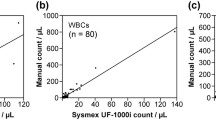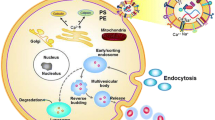Abstract
Background
Among dysmorphic urinary erythrocytes (D cells), G1 cells or doughnut-shaped erythrocytes with one or more blebs are considered to be reliable markers for glomerular diseases. However, although there are many D cells with cytoplasmic color loss and without blebs in the urinary sediment, the significance of these cells is not clear. In this study, we devised a classification system for D cells and examined the relation between these cell types and urinalysis data.
Methods
We classified D cells into three types (D1, D2, and D3 cells): D1 cells showed a ring-like shape and severe loss of cytoplasmic color with protrusions or blebs; D2 cells showed a doughnut-like shape and moderate cytoplasmic color loss with protrusions or blebs; and D3 cells showed a doughnut-like shape and mild cytoplasmic color loss without protrusions or blebs. We calculated the numbers of D cells of each type in 45 patients with glomerular diseases and in 303 general outpatients. This was done by bright-field microscopy modified for the analysis of urinary sediment, and we also examined the significance of these cell types.
Results
In the 45 patients with glomerular diseases, the numbers of D1, D2, and D3 cells correlated with urine levels of proteinuria and hematuria and numbers of cellular and fatty casts. Numbers of D1 and D2 cells correlated with urine concentrations of albumin and N-acetyl-β-d-glucosaminidase, and the proportions of D1 and D2 cells in D cells increased with the activity of glomerular diseases classified by urinalysis data. Only the number of D1 cells correlated with the urine concentration of potassium, which may increase in hemolysis. In the 303 outpatients, the sensitivity of D3 cells and D1 and/or D2 cells (G1 cells) was 73% and 46%, respectively, for the detection of glomerular diseases and the specificity was 93% and 99%, respectively.
Conclusions
These data indicate that the D3 cell is a sensitive marker for glomerular diseases, and that D1 and/or D2 cells are markers for severe glomerular diseases.
Similar content being viewed by others
References
DF Birch KF Fairley (1979) ArticleTitleHaematuria: glomerular or non-glomerular? Lancet II 845–6 Occurrence Handle10.1016/S0140-6736(79)92191-3
RG Fassett BA Horgan TH Mathew (1982) ArticleTitleDetection of glomerular bleeding by phase-contrast microscopy Lancet I 1432–4 Occurrence Handle10.1016/S0140-6736(82)92451-5
KF Fairley DF Birch (1982) ArticleTitleHematuria: a simple method for identifying glomerular bleeding Kidney Int 21 105–8 Occurrence Handle1:STN:280:DyaL387ptlansw%3D%3D Occurrence Handle10.1038/ki.1982.16 Occurrence Handle7077941
DF Birch KF Fairley JA Whitworth I Forbes JK Fairley GR Cheshire et al. (1983) ArticleTitleUrinary erythrocyte morphology in the diagnosis of glomerular hematuria Clin Nephrol 20 78–84 Occurrence Handle1:STN:280:DyaL2c%2Fgt12guw%3D%3D Occurrence Handle6616978
H Köhler E Wandel B Brunck (1991) ArticleTitleAcanthocyturia – a characteristic marker for glomerular bleeding Kidney Int 40 115–20 Occurrence Handle10.1038/ki.1991.188 Occurrence Handle1921146
M Tomita Y Kitamoto M Nakayama TA Sato (1992) ArticleTitleNew morphological classification of urinary erythrocytes for differential diagnosis of glomerular hematuria Clin Nephrol 37 84–9 Occurrence Handle1:STN:280:DyaK383gtVOjsA%3D%3D Occurrence Handle1551254
Y Kitamoto M Tomita M Akamine T Inoue J Itoh H Takamori et al. (1993) ArticleTitleDifferentiation of hematuria using a uniquely shaped red cell Nephron 64 32–6 Occurrence Handle1:STN:280:DyaK3s3nsFCmtw%3D%3D Occurrence Handle10.1159/000187274 Occurrence Handle8502333
AK Dinda S Saxena S Guleria SC Tiwari SC Dash RN Srivastava et al. (1997) ArticleTitleDiagnosis of glomerular haematuria: role of dysmorphic red cell, G1 cell and bright-field microscopy Scand J Clin Lab Invest 57 203–8 Occurrence Handle1:STN:280:DyaK2szotFCgtg%3D%3D Occurrence Handle10.3109/00365519709060028 Occurrence Handle9238755
B Lettgen A Wohlmuth (1995) ArticleTitleValidity of G1-cells in the differentiation between glomerular and non-glomerular haematuria in children Pediatr Nephrol 9 435–7 Occurrence Handle1:STN:280:DyaK28%2FitFCntA%3D%3D Occurrence Handle10.1007/BF00866720 Occurrence Handle7577404
Z Zaman W Proesmans (2000) ArticleTitleDysmorphic erythrocytes and G1 cells as markers of glomerular hematuria Pediatr Nephrol 14 980–4 Occurrence Handle1:STN:280:DC%2BD3M%2FltVGhug%3D%3D Occurrence Handle10.1007/s004670050057 Occurrence Handle10975311
GK Nguyen (2003) ArticleTitleUrine cytology in glomerular diseases and value of G1 cell in the diagnosis of glomerular bleeding Diagn Cytopathol 29 67–73 Occurrence Handle10.1002/dc.10320 Occurrence Handle12889042
JT Lin H Wada H Maeda M Hattori H Tanaka F Uenoyama et al. (1983) ArticleTitleMechanism of hematuria in glomerular diseases. An electron microscopic study in a case of diffuse membranous glomerulonephritis Nephron 35 68–72 Occurrence Handle1:STN:280:DyaL3s3pslyqsQ%3D%3D Occurrence Handle10.1159/000183049 Occurrence Handle6888629
VA Briner WH Reinhart (1990) ArticleTitleIn vitro production of “glomerular red cells”: role of pH and osmolality Nephron 56 13–8 Occurrence Handle1:STN:280:DyaK3M%2Fktlaquw%3D%3D Occurrence Handle10.1159/000186093 Occurrence Handle2234244
B Rath C Turner B Hartley C Chantler (1992) ArticleTitleWhat makes red cells dysmorphic in glomerular haematuria? Pediatr Nephrol 6 424–7 Occurrence Handle1:STN:280:DyaK3s%2FptVKgtw%3D%3D Occurrence Handle10.1007/BF00874000 Occurrence Handle1457323
Y Kitamoto C Yide M Tomita T Sato (1992) ArticleTitleThe mechanism of glomerular dysmorphic red cell formation in the kidney Tohoku J Exp Med 167 93–105 Occurrence Handle1:STN:280:DyaK3s7hvVShuw%3D%3D Occurrence Handle10.1620/tjem.167.93 Occurrence Handle1475790
KJ Halbhuber R Fünfstück B Kühn R Kühn E Baumann M Klinger et al. (1994) ArticleTitleDysmorphic red cell formation in glomerulonephritis. 2. In vitro generation of dysmorphic erythrocytes Cell Mol Biol (Noisy-le-grand) 40 1125–33 Occurrence Handle1:CAS:528:DyaK2MXis1Kmu7c%3D
R Fünfstück KJ Halbhuber B Kühn R Kühn H Oehring C Scheven et al. (1994) ArticleTitleDysmorphic erythrocytes in glomerulonephritis. 1. Electron microscopical and histochemical investigation Cell Mol Biol (Noisy-le-grand) 40 1113–24
PA Hill DJ Davies P Kincaid-Smith GB Ryan (1989) ArticleTitleUltrastructural changes in renal tubules associated with glomerular bleeding Kidney Int 36 992–7 Occurrence Handle1:STN:280:DyaK3c%2Fps1yitA%3D%3D Occurrence Handle10.1038/ki.1989.292 Occurrence Handle2689755
BD Rose HG Rennke (1994) Urinalysis and approach to the patient with renal disease BD Rose HG Rennke (Eds) Renal pathophysiology—the essentials Lippincott Williams & Wilkins Philadelphia 191–210
Author information
Authors and Affiliations
Corresponding author
About this article
Cite this article
Nagahama, D., Yoshiko, K., Watanabe, M. et al. A useful new classification of dysmorphic urinary erythrocytes. Clin Exp Nephrol 9, 304–309 (2005). https://doi.org/10.1007/s10157-005-0380-9
Received:
Accepted:
Published:
Issue Date:
DOI: https://doi.org/10.1007/s10157-005-0380-9




